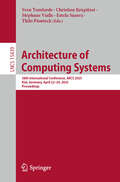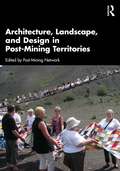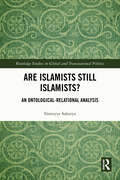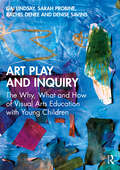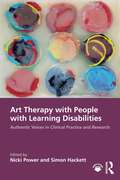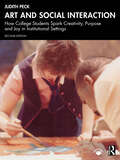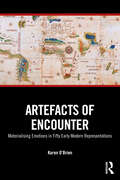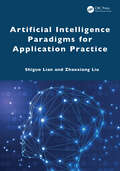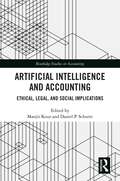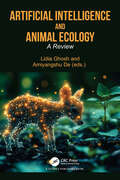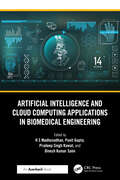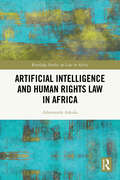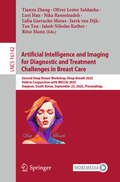- Table View
- List View
Architecture and Progress: Exploring a Progressively Problematic Built Environment
by Matt Hall Mark Alan BlumbergThis volume proposes an interdependent relationship between progress and obstacles in architecture and the built environment. It challenges the positive notion of progress, and the conception of progress and obstacle as a dichotomy.For shapers of the world, finding ‘the solution’ is often a mark of progress that becomes embedded in culture, society, and history. Progress is ever-present. Through the exploration of diverse positions in history, theory, and practice, this book explores the potential utility of the progressively problematic rather than the natural tendency towards the progressively solved. Chapters draw on historic spaces, technological advancement, incorporation of the natural world, alterative production, and the consideration of human experience both sensory and psychological. Challenging the positive connotation of ‘progress’, the writings also explore reversing the notion of obstacle from disruptive anti-tool to obstacle of utilitarian method, a useful tool, pressing approach, and overarching value system.This will be interesting reading for upper-level students and scholars of Architecture, Urban Design, Philosophy, and Sociology.
Architecture of Computing Systems: 38th International Conference, ARCS 2025, Kiel, Germany, April 22–24, 2025, Proceedings (Lecture Notes in Computer Science #15839)
by Thilo Pionteck Sven Tomforde Christian Krupitzer Stéphane Vialle Estela SuarezThis book constitutes the proceedings of the 38th International Conference on Architecture of Computing Systems, ARCS 2025, held in Kiel, Germany, in April 2025. The 24 full papers presented together with 12 other papers in this volume were carefully reviewed and selected from 49 submissions. These papers have been categorized in the following sections: self-powered embedded systems up to plant powered high-performance systems, new emerging and cross-cutting topics,such as autonomous and ubiquitous systems, reconfigurable computing, mathematical models, neural networks, and artificial intelligence.
Architecture, Landscape, and Design in Post-Mining Territories
by Post-Mining NetworkThis edited collection explores how architects, planners, and landscape architects can engage with former mining sites and communities.Chapters investigate how to move from an extractivist system towards a territorialist project, working towards the reappropriation of territorial resources after centuries of subordination of local and immigrant populations. The first part reviews cases from European sites, including examples from France, Germany, and Romania that highlight intangible heritage as the subject of a territorial project. A special focus is placed on the coalfields of northern France, a UNESCO World Heritage site since 2012, where many experimental projects are being carried out. The second part explores the great American landscapes transformed by the extractive industry in the United States, Brazil, and Chile. Fully illustrated throughout, this book features photos showcasing architectural and landscape achievements, as well as drawings of future projects. Contributors respond to the design challenges of post-mining landscapes, foreshadowing new and varied transformative horizons. The cases present a rich and articulate collection of ‘on-the-ground’ projects.This book is essential for practitioners and students of architecture and urban planning, as well as associations and political and technical actors in post-mining communities.
Arduino VIII: Portenta Machine Control (Synthesis Lectures on Digital Circuits & Systems)
by Steven F. BarrettThis book is about the Arduino microcontroller and the Arduino concept. The visionary Arduino represented a new innovation in microcontroller hardware in 2005, the concept of open source hardware, making a broad range of computing accessible for all. This book, &“Arduino VIII: Portenta Machine Control,&” is an accessible primer on industrial control and programmable logic controller concepts for those without a deep instrumentation background. An understanding of basic circuit theory is an appropriate prerequisite for the book. The three main goals for the book are: explore accessible Arduino Portenta Machine Control industrial control products; learn the fundamentals of programming using ladder logic; and explore related sensors and interface concepts. We use multiple examples throughout the book and conclude with an instrumented greenhouse project.
Are Islamists Still Islamists?: An Ontological-Relational Analysis (Routledge Studies in Global and Transnational Politics)
by Sümeyye SakaryaThis book offers an ontological study of Islamism and its transformation with a specific focus on Türkiye, Bangladesh, and Senegal.The dominant reading of the transformation of Islamism from a discernibly Islamist, then anti-systemic discourse to a more systemic one has been through the arguments of post-Islamism, which claim the failure and end of Islamism. However, this assumes that Islamists are still Islamists, which is an oxymoron. This book suggests that this scholarship fails to recognise the political, ontological nature of Islamism. It argues that under-theorisation of the political, accompanied by Eurocentrism and positivism, hinders a proper understanding of Islamism by engendering methodological nationalism and state-centrism and obstructing Islamists as political actors by denying them political agency to undertake transformation. This shows the need for an ontological analysis to surmount the mentioned problems and comprehend Islamists as political actors by disarticulating any necessary relationship between the political and any fixed entity, such as the state, a specific rhetoric or form. The book, as an exercise in political theory, offers such an analysis, articulated through the tools provided by post-foundationalist political theory, particularly the works of Martin Heidegger, Antonio Gramsci, Hannah Arendt, and Salman Sayyid, who mobilises Carl Schmitt and post-Marxist discourse theory to read Islamism.This book will appeal to scholars and students of Politics, International Relations, Area Studies, and Sociology, especially those specialising in Islam and Islamism.
Arguing About Political Philosophy (Arguing About Philosophy)
by Matt Zwolinski Mario I. Juarez-GarciaThis third edition of Arguing About Political Philosophy is the most complete, up-to-date, and interdisciplinary anthology of its kind. Its selections cover classic philosophical sources such as those from Thomas Hobbes and John Rawls, important works in political economy from thinkers like Adam Smith, Friedrich Hayek, and Karl Marx, and the writing of cutting-edge contemporary theorists like Debra Satz, Jason Brennan, and Ta-Nehisi Coates.The third edition has been substantially revised to make it more suitable for a growing number of courses in philosophy, politics, and economics (PPE). New topics and new readings help to explore the intersection of these three disciplines at a theoretical level, and how they help us to think about challenging practical problems like regulating sweatshop labor, reconciling immigration policy with social justice, and thinking about the virtues and limits of democracy.In addition to offering sections on foundational concepts, political economy, and contemporary debates in political philosophy, the third edition contains a brand-new section on political ideologies, with a new introduction and accessible readings setting out the main features of liberalism, socialism, conservatism, and libertarianism.The updated Instructor and Student Resource website www.routledge.com/cw/zwolinski offers valuable resources for instructors and students alike, including sample quizzes, exams, and writing assignments, extensive study questions for each reading, and an online version of the "What’s Your Political Philosophy" self-assessment.Key Updates to the Third Edition: Includes more interdisciplinary readings from economists and political scientists. Contains readings that make the volume a better fit for new programs in philosophy, politics, and economics (PPE). Offers a better representation of diverse ideological perspectives. Provides new coverage of emerging topics like reparations for past injustice, sweatshop labor, immigration policy, effective altruism, and the value of democracy. Updates the important parts on the book’s website: sample quizzes, exams, and writing assignments, extensive study questions for each reading, and an online version of the "What’s Your Political Philosophy" self-assessment.
Art Play and Inquiry: The Why, What and How of Visual Arts Education with Young Children
by Gai Lindsay Sarah Probine Rachel Denee Denise SavinsCombining theoretical inspiration, practical guidance, and visual examples, this book empowers educators to implement rich visual arts experiences and foster joyful, art-centered learning environments with children.Drawing upon decades of experience and research, the authors offer rich, practical, plain English information alongside inspiring images, reflection points, and visual examples to support educators to understand the WHY, WHAT, and HOW of designing and delivering a rich visual arts curriculum for and with young children. Making no assumptions about prior visual arts knowledge or experience, this informative, visually beautiful book connects theory and practice, while providing guidance to inspire and inform interactions with children and visual arts materials in meaningful ways.This is an essential resource for educators, teachers, parents, students or academics aiming to enhance their teaching practices and enrich children's learning through visual arts. Whether you are new to visual arts education or looking to deepen your practice, this book will inspire and equip you to support children's creative and expressive potential.
Art Therapy with People with Learning Disabilities: Authentic Voices in Clinical Practice and Research
by Nicki Power Simon HackettArt Therapy with People with Learning Disabilities brings together diverse, international contributions from practitioners, researchers and clients within the field of art therapy to inform best practice when working with people with learning disabilities. Focusing on four core themes – justice, agency, advocacy and connection – this engaging volume invites readers into the transformative world of art therapy, where creativity serves as a powerful tool for self-expression and positive change.Emphasising the voices and experiences of individuals with learning disabilities, many chapters are co-authored with clients who bring invaluable lived experience, which offers readers a fresh perspective on art therapy in practice. These insights are woven together in a rich tapestry of case studies, intervention descriptions and consideration of therapist positionality to illustrate how art therapy can empower people with learning disabilities.Readers will gain practical insights, evidence-based approaches and a variety of creative techniques that can be applied to both clinical and research settings. This book demonstrates how art therapy facilitates self-expression and fosters personal agency, making it a compelling read for both new and seasoned art therapists alike. It will also resonate with educators and healthcare professionals seeking to enhance their understanding and application of inclusive art therapy practices across a range of health, social care and educational settings.
Art and Psychoanalysis: Between the Dialectics of the Other and Poetic Estrangement (The International Psychoanalytical Association Current Challenges in Psychoanalysis)
by Gabriela GoldsteinThis book explores the concept of estrangement from a psychoanalytic perspective, intertwining art and aesthetics to offer a paradigm of the aesthetic experience.Gabriela Goldstein suggests that an unexpected encounter with a work of art may lead to a state of poetic estrangement, promoting a possible reorganization of its subject’s psychic economy. The conceptual work is illuminated with vignettes exploring the experience of this state of estrangement, reflecting on the encounter between the subject and the other/Other, between analyst and patient and in the framework provided by the analytical situation. Finally, Goldstein considers how the metapsychology of aesthetic experience and its research contribute to clinical understanding of processes of deficient symbolization.Art and Psychoanalysis will be key reading for psychoanalysts, artists, researchers, and teachers of art and psychoanalysis. It will also be of great interest to art therapists, students of art and the humanities, as well as other readers interested in an in-depth understanding of the aesthetic experience and creative processes.
Art and Social Interaction: How College Students Spark Creativity, Purpose and Joy in Institutional Settings
by Judith PeckThis second edition expands upon a program that teaches expressive visual arts activities to college students to share with individuals in jails, nursing homes, psychiatric facilities, domestic abuse shelters and youth care centers.Creating expressive art through interaction with those affected, students gain an intimate awareness of crime; mental illness; substance, child, domestic abuse; and aging—critical issues of our time. Specially designed projects in drawing, painting, collage, sculpture and crafts are supplemented with student reflections on how the experience influenced their lives and future careers plus institutional evaluation on the effectiveness of the program on their clientele. Delivering everything needed to set up the course in any liberal arts college, the bookcovers planning, execution, projected outcomes and evaluation, offering students an education relevant to their lives and careers while giving institutions a dynamically effective program of self-enhancement through the arts.Colour versions of many projects can be viewed online at www.routledge.com/9781032972008.
Art, Politics, and Palace Eunuchs in Ming China, 1368–1644 (Routledge Research in Art History)
by Scarlett JangThis is the first in-depth analysis of the place of the Ming palace eunuchs in the social history of Chinese art, examining the intricate intersections of art, politics, and palace eunuchs in the Ming dynasty.In addition to articulating the elite eunuchs’ roles as important power brokers in the political arena, this monograph offers a balanced view of Ming eunuchs, with evidence of their accomplishments as book authors, editors, and compilers, poets, calligraphers, and art collectors, the Confucian scholars’ typical literati pursuits. By exploring both the positive and negative roles that palace eunuchs played in the Ming’s visual culture, this book reveals that Ming palace eunuchs, as supervisors of both the imperial art collection and the imperial art academy, and as powerful art collectors themselves, made various significant impacts on the contemporary art criticism, art market, and art-collecting patterns.The book will be of interest to scholars working in art history, Sinology, and Chinese studies.
Artefacts of Encounter: Materialising Emotions in Fifty Early Modern Representations
by Karen O'BrienThis book presents corresponding images and essays of fifty early modern artefacts of encounters between European explorers and indigenous peoples, addressing relationships and material exchanges that extend beyond this framework to encompass diverse interactions across early modern societies.The artefacts selected for inclusion in this volume convey early modern visual dialogues, value systems and imagery through paintings, photographs, maps, drawings, buildings, books, icons, sacred sites and entities, dwellings and natural settings. Placing these objects within a comparative and international context, O’Brien considers the representation of these interactions as they are expressed through a wide gamut of human emotional experiences such as life, death, grief, pain, pleasure, belief, sadness and conflict, along with the extended perspective of image reproduction. In doing so, the book locates the realities of early modern existence – the emotional, legal, spiritual and violent encounters that encompass everyday experiences – in an expansive and varying spatial, cultural, geographical and temporal context. The book will interest students, scholars and general readers within a broad range of history subdisciplines including early modern history, indigenous history, comparative history and socio-legal history, and is also a useful text for undergraduate courses in politics, law, indigenous studies and global studies.
Artificial General Intelligence: 18th International Conference, AGI 2025, Reykjavic, Iceland, August 10–13, 2025, Proceedings, Part I (Lecture Notes in Computer Science #16057)
by Michael Bennett Matthew Iklé Anton KoloninThis book constitutes the refereed proceedings of the 18th International Conference on Artificial General Intelligence, AGI 2025, held in Reykjavic, Iceland in August 2025. The 72 full papers included in this book were carefully reviewed and selected from 179 submissions. They were organized in topical sections as follows: novel learning algorithms, reasoning systems, theoretical neurobiology and bio-inspired systems, quantum computing, theories of machine consciousness, ethics,safety, formal mathematical foundations and philosophy of AGI.
Artificial General Intelligence: 18th International Conference, AGI 2025, Reykjavic, Iceland, August 10–13, 2025, Proceedings, Part II (Lecture Notes in Computer Science #16058)
by Michael Bennett Matthew Iklé Anton KoloninThis book constitutes the refereed proceedings of the 18th International Conference on Artificial General Intelligence, AGI 2025, held in Reykjavic, Iceland in August 2025. The 72 full papers included in this book were carefully reviewed and selected from 179 submissions. They were organized in topical sections as follows: novel learning algorithms, reasoning systems, theoretical neurobiology and bio-inspired systems, quantum computing, theories of machine consciousness, ethics,safety, formal mathematical foundations and philosophy of AGI.
Artificial Historians
by Anne Martin Marnie Hughes-Warrington Lewis Yarlupurka O'BrienThis book offers readers an introduction to the world of artificial histories and historians. It looks behind the interfaces of AI and explores everyday platforms and prize-winning history books to identify how people and algorithms make histories and how they might make histories in the future.Every moment around the globe, histories are made about ordinary people who use digital devices. These histories are not made by professional historians or even by humans but by artificial intelligence that scours our digital footprints for patterns. AI histories not only shape recommendations about what we might buy or stream but also our access to education, healthcare, and justice. The outcomes of recommendation systems are not just a technology problem or an ethics problem. This book argues that this is also a history problem, and it needs to be understood as one if we are to make fairer or more just systems. It shows us that the deep history of history making—including Australian Aboriginal and First Nations histories—can help us to navigate the future of history in AI.Presenting readers with a range of familiar and accessible examples, Artificial Historians is a valuable resource for students, scholars, and all those interested in global historiography, technology, and artificial intelligence.
Artificial Intelligence Learning Facilitators: Creating Smart Education Systems (Innovations in Intelligent Internet of Everything (IoE))
by Fadi Al-TurjmanArtificial Intelligence Learning Facilitators: Creating Smart Education Systems delves into the various AI-based techniques, such as machine learning and natural language processing, that can help in automating management tasks such as lecture preparation, students’ performance evaluation, and predictive performance assessment. It highlights the importance of AI in handling the increasing learning complexities. The book explores the use of AI-based virtual assistants and chatbots in enhancing teaching services for students and instructors. It also discusses the potential of AI in creating personalized and targeted learning experiences. The centerpiece of the book is a presentation of the learning and teaching system, AI Prof. DUX. The use cases cover such scenarios as: Question generation for quizzes and exams The development and implementation of lecture scheduling The lecture notes’ generator Examination platform Lecture video link generation Classroom chat platform Courses management The book is an exploration of the crucial role of AI as a game-changer in educational transformation. It emphasizes how AI can positively impact various aspects of smart education systems.
Artificial Intelligence Paradigms for Application Practice
by Shiguo Lian Zhaoxiang LiuThis book proposes practical application paradigms for deep neural networks, aiming to establish best practices for real-world implementation.Over the past decade, deep neural networks have made significant progress. However, effectively applying these networks to solve various practical problems remains challenging, which has limited the widespread application of artificial intelligence. Artificial Intelligence Paradigms for Application Practice is the first to comprehensively address implementation paradigms for deep neural networks in practice. The authors begin by reviewing the development of artificial neural networks and provide a systematic introduction to the tasks, principles, and architectures of deep neural networks. They identify the practical limitations of deep neural networks and propose guidelines and strategies for successful implementation. The book then examines 14 representative applications in urban planning, industrial production, and transportation. For each case, the authors present a landing paradigm that effectively addresses practical challenges supported by illustrations, background information, related work, methods, experiments, and conclusions. The experimental results validate the effectiveness of the proposed implementation approaches.The book will benefit researchers, engineers, undergraduate, and graduate students interested in artificial intelligence, deep neural networks, large models, stable diffusion models, video surveillance, smart cities, intelligent manufacturing, intelligent transportation, and other related areas.
Artificial Intelligence and Accounting: Ethical, Legal, and Social Implications (Routledge Studies in Accounting)
by Manjit Kour Daniel P. SchutteIn the dynamic field of accounting, where accuracy and productivity are critical, artificial intelligence (AI) integration has become a game-changer and AI is set to affect every industry. With the speed at which technology is developing, a thorough manual that helps readers understand the complex world of AI in accounting is desperately needed. By offering a sophisticated grasp of how AI is changing the core ideas of accounting and financial management, this book bridges this knowledge gap. It explores the relationship between AI technology and accounting processes, revealing the significant influence and unrealised potential outside of traditional bookkeeping.This book delves into how AI is revolutionising accounting procedures. It explores the newest AI technologies and their uses in financial data processing, auditing, compliance, and forecasting, ranging from machine learning to predictive analytics. It ensures responsible AI integration by addressing biases, accountability, and transparency while emphasising ethical considerations. This book provides case studies, practical advice, and examples from the real world, guaranteeing that readers not only understand the theoretical foundations of AI in accounting but also get the knowledge necessary to apply and maximise these technologies within their professional domains by connecting theory and application. It offers a road map for traversing the accounting industry's AI frontier, from using predictive analytics to make well-informed decisions to automating repetitive activities.This book will enable accountants, auditors, and financial analysts to prosper in the emerging AI-driven world.
Artificial Intelligence and Animal Ecology: A Review
by Lidia Ghosh Amiyangshu DeArtificial Intelligence and Animal Ecology: A Review explores the transformative synergy between AI and animal ecology, unveiling how cutting-edge technology is revolutionizing ecological research and conservation. This pioneering book bridges these dynamic fields, demonstrating how AI techniques—such as evolutionary algorithms and optimization methods—both draw inspiration from and advance the study of animal behavior, species interactions, and environmental adaptation. With a strong focus on innovation, it examines groundbreaking AI applications, from bio-inspired algorithms and adaptive learning to breakthroughs in animal communication and behavioral analysis. Readers will gain valuable insights into how AI deciphers complex ecological dynamics, including navigation, vocal communication, and interspecies relationships. The book also addresses ethical considerations, ensuring responsible AI integration in ecological research.More than just a review, this book is a call to action. It empowers researchers, conservationists, and ecologists to embrace AI-driven solutions, fostering interdisciplinary collaboration and expanding the frontiers of ecological knowledge. As AI continues to evolve, Artificial Intelligence and Animal Ecology: A Review provides a vital roadmap for addressing environmental challenges with innovation and a deeper appreciation of the natural world.
Artificial Intelligence and Cloud Computing Applications in Biomedical Engineering
by Punit Gupta Dinesh Kumar Saini Pradeep Singh Rawat H S MadhusudhanBiomedical engineering is undergoing a transformation because of AI, which is allowing creative solutions that enhance patient outcomes, diagnosis, treatment planning, and healthcare delivery. Artificial Intelligence and Cloud Computing Applications in Biomedical Engineering examines the salient characteristics of AI in biomedical engineering, highlighting its practical applications and new directions. Highlights of the book include: Genome sequence and visualization The role of AI and cloud in detection of diseases Nature-inspired algorithms for disease detection Frameworks for disease classification With a focus on designing AI techniques for disease detection, the book explores the role of AI in biomedical engineering. It discusses how machine learning (ML) and deep learning (DL) are at the heart of AI applications in biomedical engineering. ML algorithms, particularly those based on neural networks, enable computers to learn from large datasets, identify patterns, and make predictions or decisions without explicit programming, and implementing ML algorithms is a focus of the book. Another focus is on DL, a subset of ML, and how it uses multi-layered neural networks to achieve high accuracy in such complex tasks as image and speech recognition. Biomedical engineering generates massive amounts of data from medical imaging, genomic sequencing, wearable devices, electronic health records (EHR), and other sources. This book also discusses AI-driven big data analytics, which allows researchers and clinicians to derive from data meaningful insights, aiding in early disease detection, personalized treatment plans, and patient monitoring.
Artificial Intelligence and Computer Vision for Ecological Informatics
by Sanjeev Jain Akhilesh Tiwari Siddharth Singh Chouhan Uday Pratap Singh Akash SaxenaEcological informatics, more commonly known as Ecoinformatics, is the study of environmental sciences and ecological information. It is an emerging interdisciplinary framework for the management, analysis, and synthesis of ecological data with the help of advanced computational intelligence algorithms. Management in this context is data acquisition, preprocessing, and sharing the data. Analysis and synthesis are the process of extracting useful information and forecasting with the help of intelligent algorithms.The aim of this book is to encapsulate concepts and theories of artificial intelligence and computer vision algorithms used for the evaluation of various ecological informatics applications. It focuses on soft computing, machine learning, deep learning, artificial intelligence, bio-inspired algorithms, data analysis tools, data visualization tools, and computer vision algorithms used in ecological informatics. The book covers remote sensing applications, water bodies evaluation, agriculture mapping, aquatic mapping, forest management, and terrestrial ecosystems.The book will be useful to students, researchers, scientists, and field experts in directing their work towards this domain, to deliver and design models and prototypes for the benefit of society and the environment.
Artificial Intelligence and Digital Forensics: Advancements, Applications, Challenges, and Solutions
by Archana Patel Naveen Kumar Chaudhary Abinash Mishra Chothmal KumawatArtificial Intelligence (AI) has revolutionized several sectors, with digital forensics being one that has been notably affected by its rapid advancement. AI brings previously unheard-of powers to this field, helping authorities examine large datasets, identify developments, and uncover digital evidence that is essential to cracking cybercrimes. Despite these promising developments, using AI in digital forensics presents problems. The complexity and dynamic nature of cyber-attacks are a significant challenge, demanding the ongoing adaptation of AI models to new attack strategies. This changing environment makes it difficult to create reliable and future-proof solutions. This book explores the advancements, applications, challenges, and solutions that AI brings to the realm of digital forensics.Artificial Intelligence and Digital Forensics: Advancements, Applications, Challenges, and Solutions includes the latest applications and examples with real data making the book meaningful for readers. It is written in very simple language with each technology having its dedicated chapter that explains how it works and provides an example of a real-world application. Key points and a summary are provided at the end of each chapter to enable the readers to quickly review the major concepts as it presents a practical understanding, so the readers can be better equipped to handle AI-based tools with ease and efficiency. The book provides unconditional support to those who are making decisions by using massive data from their organization and applying the findings to real-world current business scenarios addressing the challenges associated with integrating AI into digital forensics and offering practical solutions. It also offers insights into the ethical use of AI technologies and guidance on navigating legal requirements and ensuring responsible and compliant practices.This book caters to industry professionals from diverse backgrounds, including engineering, data science, computer science, law enforcement, and legal experts, fostering a holistic understanding of the subject along with providing practical insights and real-world examples.
Artificial Intelligence and Finance: Competition, Crimes and Financial Management (Routledge Studies in the Economics of Business and Industry)
by Georgios I. ZekosArtificial Intelligence (AI) has been increasingly shaping the organization and operation of global capital markets by backing the consequences of algorithmic trading. However, concerns about the growing contribution of AI are mounting, particularly in relation to its potential to destabilize fair and orderly trading. This book examines the impact of AI upon Finance, financial management, competition and crimes. It presents the AI-driven economy by combining a theoretical framework with econometric analysis and involves a discussion of the intersection of novel areas, including blockchain and AI. It investigates the AI-driven economy from four perspectives: economic impacts and financial implications, technological innovation and political considerations. This interdisciplinary approach enables a holistic analysis of the subject, ensuring its relevance. The book begins by signalling the latest advancements in AI and its significance for the economy, presenting new forms of finance. It investigates the role of AI within financial markets, followed by an analysis of the role of AI upon developments in finance, financial management and governance, with an emphasis on metaverse and Non-Fungible Tokens (NFTs), Central Bank Digital Currencies (CBDCs), cyber assets and digital currencies. The role of competition upon finance is highlighted and financial crimes and their influence upon financial markets is examined. The book will find an audience among researchers and students in the field of economics, finance or business, as well as economists, lawyers, and financial and cybersecurity professionals.
Artificial Intelligence and Human Rights Law in Africa (Routledge Studies on Law in Africa)
by Aderomola AdeolaThis book examines artificial intelligence (AI) in Africa from a rights-based perspective. In recent years, technology has emerged as a significant disruptor, with AI, robotics and computer advancement in particular driving changes in societies around the world. There are evident and daunting implications across contexts and continents, and many countries are rapidly seeking to define patterns of solutions that can foster effective protection against the more challenging impacts of AI.This book considers the consequences of AI for civil and political rights, social, economic, and cultural rights, and collective rights in Africa, with particular reference to the African Charter. It considers how AI risks violating the rights enshrined in the Charter and considers how the norms outlined in the African Charter can provide the basis for a response. Overall, this book examines how a rights-based approach to AI can be realized, emphasising the imperatives for steering implementation.Providing an important guide for strategic action for the protection of human rights in the context of AI, this book will be an important read for researchers, policymakers and students in the fields of human rights and technology in Africa.
Artificial Intelligence and Imaging for Diagnostic and Treatment Challenges in Breast Care: Second Deep Breast Workshop, Deep-Breath 2025, Held in Conjunction with MICCAI 2025, Daejeon, South Korea, September 23, 2025, Proceedings (Lecture Notes in Computer Science #16142)
by Tianyu Zhang Tao Tan Luyi Han Jakob Nikolas Kather Oliver Lester Saldanha Nika Rasoolzadeh Lidia Garrucho Moras Jarek Van Dijk Ritse MannThis book constitutes the refereed proceedings of the Second Deep Breast Workshop on Artificial Intelligence and Imaging for Diagnostic and Treatment Challenges in Breast Care, Deep-Breath 2025, held in conjunction with the 27th International Conference on Medical Imaging and Computer-Assisted Intervention, MICCAI 2025, in Daejeon, South Korea, on September 23, 2025. The 35 regular papers presented in this book were carefully reviewed and selected from 62 submissions.The Deep-Breath workshop provides an international platform for the presentation of – and discussion on – studies related to artificial intelligence in breast imaging. By fostering collaboration between clinicians and AI experts,the workshop promotes the development and responsible application of AI technologies across the breast cancer care continuum. Deep-Breath aims to create a unique forum where technical advances and clinical insights converge, driving innovation that ultimately leads to real-world impact for both physicians and patients.

